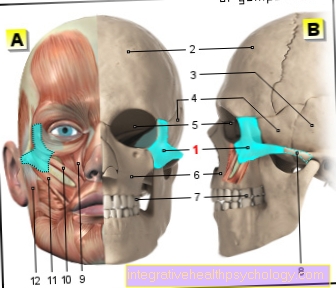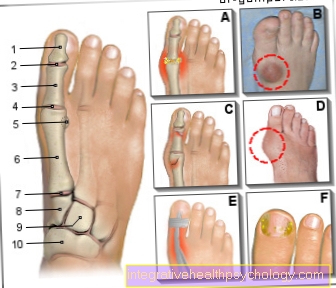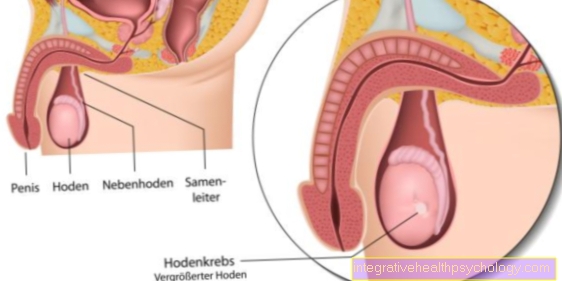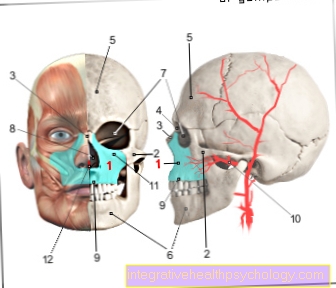Early detection of dyslexia
Synonyms in a broader sense
Features, symptoms, abnormalities, early warning, reading and spelling weaknesses, LRS, reading and spelling weaknesses, reading and spelling weaknesses, dyslexia, dyslexia, isolated or circumscribed reading and spelling weaknesses, learning impairment in reading and spelling, reading and spelling disorder, learning difficulties in German, learning difficulties in Reading and spelling, dyslexia.
Definition of early detection
All children who have problems (in the written language area) have a right to support - regardless of whether this is to a Dyslexia (Partial performance disorder with at least average intelligence) or general school problems, for example in combination with a Arithmetic weakness, one ADS or ADHD, one Poor concentration or similar is due.
There are opportunities to recognize reading and spelling difficulties or even dyslexia at an early stage, but this requires openness and requires basic knowledge that enables errors and abnormalities to be interpreted in the first place.
Children at risk
In contrast to numeracy problems, according to current studies in the area of reading and spelling weaknesses, there are more boys than girls who have problems with reading and spelling.
The studies also showed that in most cases this imbalance could be proven before school started. It is therefore assumed that there is a close connection between early abnormalities and later problems in the area of reading and spelling.
It has not been conclusively clarified why boys tend to have problems with reading and spelling more often, and thus also suffer more often from dyslexia. In addition to genetic dispositions, hormonal differences are also assumed, but also the fact of the self-fulfilling prophecy: Children who have little self-confidence in their own performance, who do not like to speak German and who may even develop fear of it more often have problems with reading and spelling . It is the same with children who have a negative attitude towards school - for whatever reason.
Children with other learning problems, such as an existing lack of concentration, ADD with or without hyperactivity, but also weaknesses in numeracy, can also tend to develop problems in the written language area.
Learning requirements of school beginners

A child does not come to school as a “blank slate”. It already had in the preschool area there is a lot of contact with the written language. So it is not surprising that children are able to demonstrate the full range of capabilities when they enter school.
There are among other things:
- the child, who can write down sentences with very few mistakes in his written language development
- the child who communicates on the spoken language level and
- the child whose “writing” is completely illegible.
Children go through different stages of written language acquisitionthat can take and last different lengths of time.
There are different models that describe the development of the written language and divide it into stages.
The Gudrun Spitta model corresponds to our observations in many areas. They are described in the table below. The age assigned to a level describes approximate values. Fluctuations in both directions are conceivable.
First of all, a few comments for a better understanding:
- Sounds or phonemes are spoken Letters / letter combinations,
- Graphemes are written Letters / letter combinations.
One speaks of one Phoneme - grapheme assignment one wants to express that a spoken letter or a spoken letter combination is assigned the corresponding character.
1st phase:
- also: called the pre-communicative phase
- at the age of about 2 years
- Children learn from models, see adults write, imitate
- Doodle pictures are created
- As a rule, scribble pictures only consist of lines that are criss-crossed.
2nd phase:
- also: called the pre-phonetic phase
- Around 3 to 5 years old
- Doodle pictures, however, the painted characters resemble some letters
- Recognize children: Adults use letters for specific reasons
- Later it becomes clear: adults use letters to communicate with each other
3rd phase:
- also: called semaphonic phase
- at the age of about 3 to 5 years
- Children recognize: writing represents language
- Children make their first attempts at writing
- Usually “word skeletons” are written. This means that children at this level mostly do not use vowels (a, e, i, o, u) when “writing”. This is due, among other things, to the fact that adults “spell” letters and not make them sound: Be, Ce, De, Eff, Ge, Ha.
- Example of a word skeleton: Ptr instead of Peter.
- !!! Use the phonetic method and name letters in front of your child after the respective sound. This makes work easier in the first year of school, in which all letters and connections are introduced according to sounds.
4th phase:
- also: called the phonetic phase
- aged about 5 to 7 years
- Recognize children: sounds are represented by letters.
- Children write “spoken”, that is, as they speak.
- Example: alalipster brother instead of dearest brother, stones instead of stones, ...
5th phase:
- Phonetic transcription phase with increasing integration of spelling rules
- Approximately in the first or second year of school (around the age of 6 to 7 years)
- Children recognize: You can read and understand what I write, but there are additional rules that you have to adhere to when writing.
- Problems that arise through the realization: Overcorrection: Vata becomes father, but also papa becomes paper etc.
6th phase:
- Phase in which the transition to developed spelling skills is made.
- from about 8 years
- Phoneme - grapheme assignment is safely mastered
- first rules, such as: upper and lower case rules are applied
- Parts of speech, word families, endings and prefixes are used to clarify the spelling.
- Expansion of the basic vocabulary and its increasingly secure mastery.

Children therefore come to school at different “spelling stages”. The task of the first lesson is to get them all “under one roof” in the first class and to encourage each child individually and to keep the motivation high. The situation is similar with the initial learning situation with regard to reading skills.
A child does not have to learn to read and write before starting school. This learning process usually takes place in school! The following table lists the basic requirements that were important for the previous development of written language and reading and will also be of great importance for the subsequent development stages.
These are:
Perception in particular plays a special role in preparation for learning to read and write. A distinction is made between different language perception services, which are indispensable for the process of learning to read and write and which in a certain way connect the different areas of perception with one another.
There is also the need for a child to be able to concentrate for a certain period of time. In the first year of school, a child should be able to concentrate on a task for a period of 15 to 20 minutes. If it can't, it doesn't mean that there is a lack of concentration. But it means that the ability to concentrate should be trained.
The many differences and different starting points for learning primarily require an educational transition from kindergarten to primary school. It often turns out that many problems only exist initially and resolve on their own without further interference. But there are also - and this must not be concealed - children, theirs School enrollment problems solidify and can trigger real crises - up to and including school phobia. Symptoms for this can be: aggressiveness, restlessness ("fidgeting"), inattention, "unfounded" crying, learning blocks, excessive demands, ...
It is therefore of enormous importance that the transition must be designed in such a way that success in (secondary) school is likely. However, this is not only the sole task of the kindergarten and school, but also the task of the parents, who significantly influence and support the child's development and upbringing. Many problems that arise in school can - with the right sensitivity and the appropriate diagnostic measures and skills - be identified in the child's pre-school development.
Speech perception
As already indicated above, the ability to perceive speech is closely related to general perception. One can even say that it would not be possible at all without the development of general perceptual abilities. But this also means that perception training has an enormous influence on learning to read and write.
Breuer / Weuffen differentiate between different language perception skills, so-called differentiation skills, which form the basis for all language, writing and reading skills.
If problems in the following areas are not recognized early, partial performance weaknesses such as dyslexia or dyscalculia can result, or a reading and writing weakness (LRS) or a weakness in arithmetic can develop.
A distinction is made between:
The ability to distinguish in ...
... optical - graphomotor area:
- Prerequisite for learning to read and write. Prerequisite for the ability to convert what is heard into writing and writing into verbal things
- Copying letters is difficult, as is the tracing of simple symbols.
- Optical confusion of letters that look similar (b / d / q / p), ...: space - position - instability which can “grow out” or, in the worst case, solidifies due to a weakness in the letter - sound - assignment .
- Guessing words while reading
- Missing letters when writing (word skeletons)
- ...
... phonematic - acoustic range:
- Good hearing is a prerequisite for success in this area.
- Good skills in this area are a prerequisite for correct pronunciation. Correct pronunciation enables you to write true to the sound and the correct spelling and thus to memorize the correct spelling.
- Problems distinguishing rhyming words (mouse - ostrich, ...)
- Children who do not pronounce certain sounds correctly (g is spoken as d, e.g. demalt instead of painted) can indicate phonematic weaknesses.
- Problems arise among others in children who find it difficult to hear sounds out of words. In the first year of school, after the introduction of certain sounds and letters, such sound analysis exercises are carried out. The children should decide where they hear the sound (beginning - middle - end). For example, it looks like this:
The children are shown different pictures, e.g. that of a chair, an elephant, and a flower. The children put a cross at the point where they hear the sound they are looking for, e.g. Where do you hear the “St” in the first picture (chair)? Where do you hear an “e” in the second picture (elephant) ?, Where do you hear the “e” in the third picture (flower)?
... kinesthetic - articulatory area:
- Good skills in this area are a prerequisite for confident pronunciation, correct analysis of sounds and correct pronunciation of sounds and sound connections within a word.
- A safe pronunciation presupposes that the speech motor skills are well developed and thus a child is able to understand the corresponding mouth and tongue movements that are necessary for the pronunciation of sounds.
- Speech motor skills and fine and gross motor skills are closely linked. Children who have problems in the gross or fine motor area often also have speech motor problems and vice versa.
- Checking skills by letting words repeat that are difficult to pronounce.
- Abnormal repetition is problematic because children often speak the word softly to themselves when writing a word. If it is read incorrectly, it will also be written incorrectly.
... melodic - intonational area:
- This means: the tone makes the music, in other words: the ability to recognize mood and information “between the lines” from the emphasis.
- The reaction to language is already formed in the womb, i.e. before the language is actually acquired.
- What is spoken as such is not understood. A distinction is made between positive, negative and possibly also between neutral mood.
- Studies show that around 10% of first graders have problems singing songs melodically and rhythmically correctly.
- The ability to do this, however, is the basis for the correct understanding of language.
- If children make mistakes when reading familiar words with emphasis, this always shows that the word as such has not been grasped in terms of its meaning - although it is actually known. The melody differentiation is therefore of great importance for the understanding and application of the read text.
- The ability to differentiate melodically does not necessarily imply a particular musicality in the child.
- Children with poor spelling skills often have a deficit here
... rhythmic - structuring area:
- The rhythmic recitation of language verses in combination with clapping sequences can give a first impression of a child's melodic and intonatory ability. It turns out that children with poor spelling skills have problems here.
- Rhythm does not necessarily have to appear in combination with a melody.
- Reading errors, for example the swapping and twisting of sound connections or the omission of letters, are among other things a sign that the rhythmic structure of a word has not been recorded.
- Studies have shown that children with weaknesses in the rhythmic-structuring area usually also have problems in the beginning lessons, especially in the first reading lessons and in the process of learning to write
More dyslexia issues
- Causes of Dyslexia
- Symptoms of dyslexia
- Early detection of dyslexia
- Diagnosing dyslexia
- Therapy for dyslexia
- Dyslexia - LRS
- The reading and spelling weakness (LRS)
- Partial performance weakness
related subject areas
- ADHD
- ADS
- Dyscalculia
- Giftedness
- Poor concentration
- Speech disorders
- Educational games
A list of all topics that we have published under our "Problems with Learning" page can be found under: Problems with Learning A-Z






.jpg)



















.jpg)


